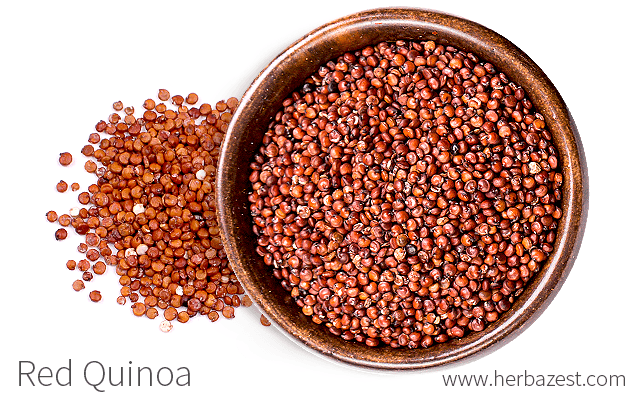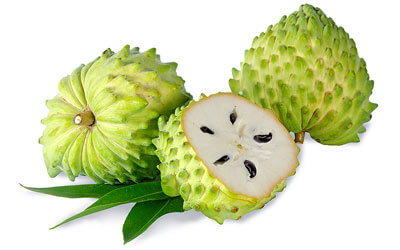While there are hundreds of different types of quinoa, the three that are most commonly encountered are white, black, and red quinoa. Of these three varieties, the main things that set them apart are their color, flavor, and texture when cooked, while nutritionally, they are practically identical.
Red Quinoa: Nutrition Facts
The nutritional value of red quinoa is very similar to its white and black counterparts. Red quinoa is a good source in protein and contains all nine essential amino acids. It is also an excellent source of many vitamins (especially vitamin B9) and minerals (such as calcium and magnesium).
The greatest difference between the different strains of quinoa is related to the pigments that give them their colors. Both black and red quinoa contain betanin and isobetanin, which are phenolic compounds with antioxidant properties, also used as colorants in cosmetics and pharmaceutical products. However, black quinoa contains these compounds in higher quantities, thus giving it its darker color.
RED QUINOA IS NUTTIER AND CRUNCHIER THAN WHITE QUINOA, BUT NOT AS CRUNCHY AS BLACK QUINOA.
Additionally, cooked red quinoa holds its shape better, and its seeds are less likely to stick together, thus making it an ideal ingredient for salads and recipes that require a grainy texture.
How to Cook Red Quinoa
To cook red quinoa, you just need to follow the same steps as other varieties of quinoa, with a slightly longer cooking time:
- Combine one cup of rinsed red quinoa in a saucepan with two cups of water.
- Bring the mixture to a boil, then cover, reduce the heat to low, and allow the quinoa to simmer until it is tender (approximately 14 - 19 minutes).
- Drain thoroughly in a fine colander.
Red Quinoa Benefits
Red quinoa offers many health benefits. For instance, a study published in Food and Nutrition Sciences (2012) found that red quinoa contains high levels of polyphenolic compounds, which gives it antioxidant properties.1 In addition, cooking and baking with red quinoa had little effect on its total phenolic content.
RED QUINOA'S HIGH ANTIOXIDANT ACTIVITY MAY CONTRIBUTE TO TREATING AND MANAGING A NUMBER OF DEGENERATIVE DISEASES LINKED TO OXIDATIVE STRESS.
Furthermore, in a study published in Food Chemistry (2015), researchers examined the antioxidant activities of white, black, and red quinoa seeds.2 Their research revealed approximately 23 phenolic compounds attributed to quinoa. Betacyanins, such as betanin and isobetanin, were shown to be the pigments responsible for the coloration of black and red quinoa. In addition, it was shown that darker quinoa has a higher phenolic concentration and antioxidant activity than lighter strains. From that, it can be deduced that red quinoa has greater antioxidant effects than white quinoa, but not as great as black quinoa.
Additionally, red quinoa calories are the same as in other strains of quinoa, and red quinoa is also gluten-free, thus making it a good source of nutrition for people with celiac disease, gluten intolerance, and wheat allergy. In fact, a study published in The American Journal of Gastroenterology (2014) found that quinoa was well tolerated by celiac patients.3 In that way, quinoa may be a good alternative to many grains, such as wheat, that are rich in gluten.
With a pleasant, nutty taste and a crunchy texture, red quinoa's nutritional value is not different from white and black quinoa, and it is equally easy to prepare, with the added advantage of its antioxidant effects. Try red quinoa as a colorful, nutrition addition to your diet!
Sources
- Molecular Nutrition & Food Research, Betanin--a food colorant with biological activity, 2015
- National Library of Medicine, National Center for Biotechnology Information, Betanin
- Quinoa: The Everyday Superfood, p. 18
- USDA Nutrient Database, Quinoa, cooked
Footnotes:
- Food and Nutrition Sciences. (2013). Total Phenolic Content and Antioxidant Activity of Red and Yellow Quinoa (Chenopodium quinoa Willd.) Seeds as Affected by Baking and Cooking Conditions. Retrieved October 15, 2021 from https://file.scirp.org/pdf/FNS20120800014_30913007.pdf
- Food Chemistry. (2015). Characterisation of phenolics, betanins and antioxidant activities in seeds of three Chenopodium quinoa Willd. genotypes. Retrieved October 15, 2021 from https://pubmed.ncbi.nlm.nih.gov/25053071/
- The American Journal of Gastroenterology. (2014). Gastrointestinal Effects of Eating Quinoa (Chenopodium quinoa Willd.) in Celiac Patients. Retrieved October 15, 2021 from https://www.semanticscholar.org/paper/Gastrointestinal-Effects-of-Eating-Quinoa-quinoa-in-Zevallos-Herencia/d34f8fb338114746bfe55d9dd61c66a050fbffb1




